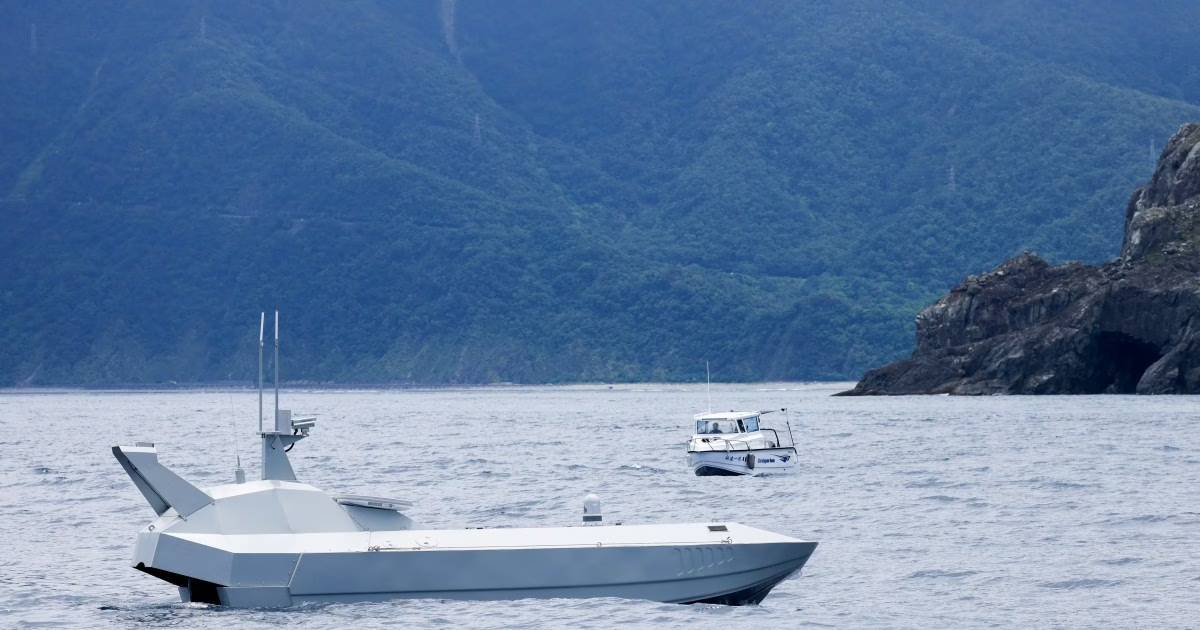<
div aria-live=”polite” aria-atomic=”true”>
Taiepi, Taiwan – On a bright morning last month, three sea drones skimmed across Su’ao Bay, off of Taiwan’s rugged northeast coast.
The tiny “stealth” Carbon Voyager 1, fast-moving Black Tide I, and the explosives-carrying Sea Shark 800 were the highlight of an expo for companies vying to help Taiwan build up a maritime drone force.
Taipei believes drones could be pivotal in repelling China in the event its forces attempt to invade the self-ruled island, which Beijing has threatened to annex by force if necessary.
Su’ao is just 60km (37 miles) away from Fulong, one of the so-called “red beaches” identified by defense experts as potential landing sites for the People’s Liberation Army (PLA) due to their unique geography.
Whereas Russia sent tanks across land borders to launch its war on Ukraine in 2022, a Chinese invasion of Taiwan would involve Beijing sending vessels across the 180-km- (112-mile-)wide Taiwan Strait.

While the Taiwan Strait’s choppy waters and Taiwan’s mountainous geography and shallow beaches pose formidable challenges to an amphibious invasion, technological advances and a decades-long modernization campaign by the PLA have steadily chipped away at the island’s natural defenses.
Faced with a drastically larger and more powerful opponent, Taiwan’s defense strategy has steadily shifted towards honing the ability to wage asymmetric warfare so that an invasion is too costly for Beijing to consider.
Drones, from sea craft to single-use suicide weapons and high-altitude intelligence, surveillance, and reconnaissance (ISR) vehicles, are a key element of Taipei’s so-called “porcupine strategy”.
“It doesn’t mean that we need to build one drone for their one drone,” Chen Kuan-ting, a lawmaker from the ruling Democratic Progressive Party who sits on the legislature’s foreign affairs and defense committee, told Al Jazeera.
Instead, Chen said, Taiwan can maintain its edge through “disruptive innovations”.
“We have to encourage startups to find something cheaper and something that would fit the terrain of Taiwan. This is our advantage,” he said.
Taiwan is no stranger to high-tech manufacturing.
The East Asian democracy is the world’s top chipmaker, thanks to Taiwan Semiconductor Manufacturing Company (TSMC), which produces about 90 percent of the most advanced semiconductors, but it also excels at making everything from wind turbines to screws and fasteners for the aerospace industry.
In 2022, Taiwan’s government launched the “Drone National Team” initiative in a bid to develop a homegrown drone industry capable of repelling a Chinese invasion and keeping up production under wartime conditions.
While Taiwan’s defense sector has been developing drones since the 1990s, Taiwanese manufacturers have long struggled to compete with the low prices offered by Chinese manufacturers, particularly Shenzhen-based DJI, which holds a more than 70 percent share of the global market.
The war in Ukraine, which has seen Kyiv make extensive use of drone warfare to hold its own against Moscow, has only reinforced the belief in Taipei that unmanned vehicles could be decisive in fending off its much bigger military foe.

Under Taipei’ s drone strategy, the Ministry of National Defence and state-owned National Chung-Shan Institute of Science and Technology, which organized June’s drone expo, are tasked with partnering with contractors to produce military-grade drones.
Under a parallel initiative, the Ministry of Economic Affairs is coordinating a program to help the private sector build and sell “dual-use” drones, which serve commercial as well as military purposes, for both the local and overseas markets.
Taiwanese President William Lai Ching-te has expressed his wish for Taiwan to become an “Asian hub” for drone technology and manufacturing.
For Taiwan, the bid to become a drone powerhouse is a race against time.
United States Admiral Philip Davidson, commander of US Indo-Pacific Command, has estimated that the PLA will be capable of invading Taiwan by 2027.
Despite the pressing need for a formidable drone force, Taiwan’s progress at building up its domestic industry has been uneven at best, experts say, with the problems beginning with overly modest targets that do not match the scale of the threat.
Taiwan has set a target for local industry to produce 15,000 dual-use drones a month by 2028, while the Defence Ministry has ordered 700 military-grade unmanned aerial vehicles (UAVs) and 3,422 dual-use drones from local manufacturers, according to figures from the government-backed Research Institute for Democracy, Society, and Emerging Technology (DSET).
Taiwan also ordered approximately 1,000 UAVs from the US in 2024 and set a new target in May to procure another 47,000 drones over the next four years.
The newer procurement figures have yet to be accounted for in the national budget, which means they are subject to possible change.

Source: https://www.aljazeera.com/news/2025/7/31/in-chinas-shadow-taiwan-is-building-a-drone-army-to-repel-an-invasion?traffic_source=rss







